I can think of two ways to do that, and since you didn't provide your exact case, i will provide a simple scenario and build my answer base on it,
let say you have a DataGrid with two editable columns (A and B), in the edit mode you can choose the A value from a combobox list, and then the B combobox will be filtered to show only the items whom their value starts with the A value for example, if A="aa", B should be {"aaaa","aabb"}, to implement that you need first a Model that represent the DataGrid Items
public class GridItem
{
public String A { get; set; }
public String B { get; set; }
}
In your codebehind / ViewModel define those properties (the DataGrid , and the comboboxes ItemSource Collections) :
private ObservableCollection<GridItem> _gridItemsCollection = new ObservableCollection<GridItem>()
{
new GridItem()
{
A="aa",
B="bbbb"
}
};
public ObservableCollection<GridItem> GridItemsCollection
{
get
{
return _gridItemsCollection;
}
set
{
if (_gridItemsCollection == value)
{
return;
}
_gridItemsCollection = value;
OnPropertyChanged();
}
}
//for the first Combobox
private ObservableCollection<String> _aCollection = new ObservableCollection<String>()
{
"aa",
"bb"
};
public ObservableCollection<String> ACollection
{
get
{
return _aCollection;
}
set
{
if (_aCollection == value)
{
return;
}
_aCollection = value;
OnPropertyChanged();
}
}
//for the second Combobox
private ObservableCollection<String> _bCollection ;
public ObservableCollection<String> BCollection
{
get
{
return _bCollection;
}
set
{
if (_bCollection == value)
{
return;
}
_bCollection = value;
OnPropertyChanged();
}
}
Define a full B collection from which your B combobox's itemsource will be populated
ObservableCollection<String> MainBCollection = new ObservableCollection<String>()
{
"aaaa",
"aabb",
"bbaa",
"bbbb"
};
Finally the population of the B combobox will be based on the selected item in the A combobox using this property,
private String _selectedAItem;
public String SelectedAItem
{
get
{
return _selectedAItem;
}
set
{
if (_selectedAItem == value)
{
return;
}
_selectedAItem = value;
OnPropertyChanged();
var returnedCollection = new ObservableCollection<String>();
foreach (var val in MainBCollection)
{
if (val.StartsWith(_selectedAItem))
{
returnedCollection.Add(value);
}
}
BCollection = new ObservableCollection<string>(returnedCollection);
}
}
You need of course to implement the INotifypropertyChanged Interface, so that the B Combobox Itemsource will be updated,
Now regarding the Xaml, due to some limitations in Xceed you need to specify the Combobox's ItemSource and SelectedItem using the RelativeSource and Ancestor binding,
<Grid >
<xcdg:DataGridControl ItemsSource="{Binding GridItemsCollection}" AutoCreateColumns="False" SelectionMode="Single" >
<xcdg:DataGridControl.Columns>
<xcdg:Column Title="A"
FieldName="A"
>
<xcdg:Column.CellContentTemplate>
<DataTemplate>
<TextBlock Text="{Binding}"/>
</DataTemplate>
</xcdg:Column.CellContentTemplate>
<xcdg:Column.CellEditor>
<xcdg:CellEditor>
<xcdg:CellEditor.EditTemplate>
<DataTemplate>
<ComboBox Name="AComboBox" SelectedItem="{Binding SelectedAItem, RelativeSource={RelativeSource FindAncestor,
AncestorType={x:Type Window}}}" SelectedValue="{xcdg:CellEditorBinding}"
ItemsSource="{Binding RelativeSource=
{RelativeSource FindAncestor,
AncestorType={x:Type wpfApplication3:MainWindow}},
Path=ACollection}">
</ComboBox>
</DataTemplate>
</xcdg:CellEditor.EditTemplate>
</xcdg:CellEditor>
</xcdg:Column.CellEditor>
</xcdg:Column>
<xcdg:Column Title="B"
FieldName="B"
>
<xcdg:Column.CellContentTemplate>
<DataTemplate>
<TextBlock Text="{Binding}"/>
</DataTemplate>
</xcdg:Column.CellContentTemplate>
<xcdg:Column.CellEditor>
<xcdg:CellEditor>
<xcdg:CellEditor.EditTemplate>
<DataTemplate>
<ComboBox Name="AComboBox" SelectedValue="{xcdg:CellEditorBinding}" ItemsSource="{Binding RelativeSource=
{RelativeSource FindAncestor,
AncestorType={x:Type Window}},
Path=BCollection}">
</ComboBox>
</DataTemplate>
</xcdg:CellEditor.EditTemplate>
</xcdg:CellEditor>
</xcdg:Column.CellEditor>
</xcdg:Column>
</xcdg:DataGridControl.Columns>
</xcdg:DataGridControl>
</Grid>
and the result is something like that


The Other way to do that is by using a MultivalueConverter and update the B Collection eachtime the A SelectedValue is changed,
something like that :
<xcdg:CellEditor.EditTemplate>
<DataTemplate>
<ComboBox Name="AComboBox" SelectedValue="{xcdg:CellEditorBinding}">
<ComboBox.ItemsSource>
<MultiBinding Converter="{StaticResource BCollectionConverter}">
<Binding Path="BCollection" RelativeSource="{RelativeSource AncestorType={x:Type Window}}"/>
<Binding Path="SelectedValue" ElementName="AComboBox" />
</MultiBinding>
</ComboBox.ItemsSource>
</ComboBox>
</DataTemplate>
</xcdg:CellEditor.EditTemplate>
And implement the converter to update the B Combobox's ItemSource,
public class BCollectionConverter:IMultiValueConverter
{
public object Convert(object[] values, Type targetType, object parameter, CultureInfo culture)
{
if (values == null)
return null;
var bCollection = (values[0] as ObservableCollection<String>);
var aSelectedItem = (values[1] as String);
if (aSelectedItem == null)
return null;
var returnedCollection = new ObservableCollection<String>();
foreach (var value in bCollection)
{
if (value.StartsWith(aSelectedItem))
{
returnedCollection.Add(value);
}
}
return returnedCollection;
}
public object[] ConvertBack(object value, Type[] targetTypes, object parameter, CultureInfo culture)
{
throw new NotImplementedException();
}
}
I didn't try that last one, you might as well give it a try, I hope that did help.

